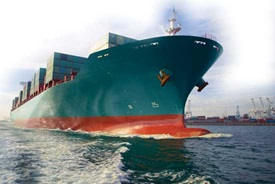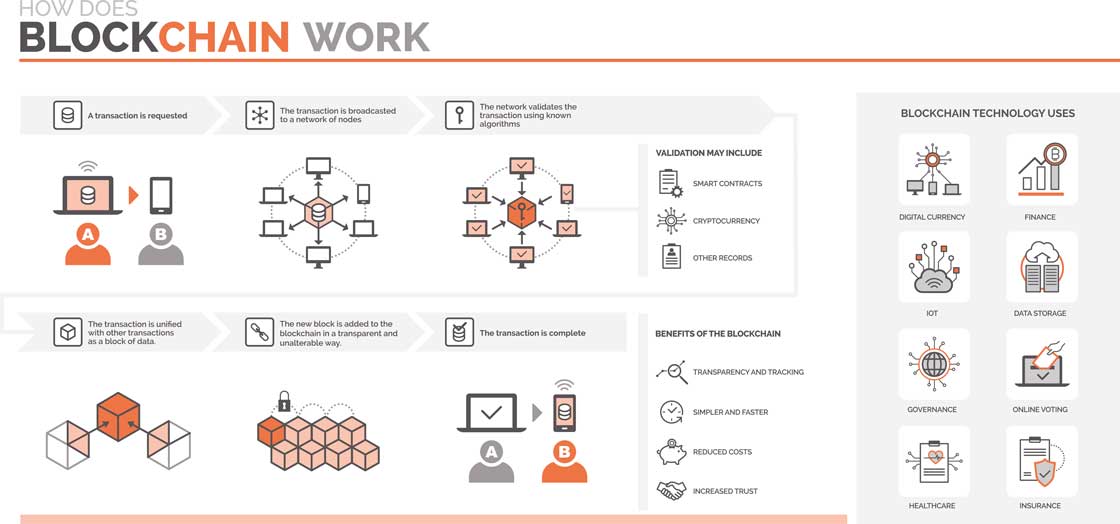The Benefits of Blockchain
FOOD SAFETY AND QUALITY
 Blockchain is a computer networking technology that creates a complete, immutable record of transactions that have been made and shares it in real time among all participants in a network. Satoshi Nakamoto first used the term blockchain in a 2008 paper that described the concept of blocks of encrypted data linked through a networked chain and created the cryptocurrency called Bitcoin as the first use of the concept the following year. Since then, much work has been done on blockchain technology, and many companies have been formed to utilize it or facilitate its use through blockchain platforms. Blockchain also has many applications outside of cryptocurrencies, especially other financial technology applications.
Blockchain is a computer networking technology that creates a complete, immutable record of transactions that have been made and shares it in real time among all participants in a network. Satoshi Nakamoto first used the term blockchain in a 2008 paper that described the concept of blocks of encrypted data linked through a networked chain and created the cryptocurrency called Bitcoin as the first use of the concept the following year. Since then, much work has been done on blockchain technology, and many companies have been formed to utilize it or facilitate its use through blockchain platforms. Blockchain also has many applications outside of cryptocurrencies, especially other financial technology applications.
The concept has many potential uses related to food, such as providing detailed information regarding all transactions in a food supply chain from the source to the end user, enabling transparency, traceability, rapid determination of the cause of a foodborne illness outbreak or food fraud, and other purposes, including financial and marketing opportunities such as substantiation of product claims. It has the potential to directly connect all participants in the food supply chain, including farmers, processors, distributors, suppliers, retailers, and regulators with a shared immutable view of their transaction history. It can also connect consumers to information about the foods they consume.
How Blockchain Works
A blockchain is essentially a distributed ledger that is encrypted, synchronized, and shared among all participants in the network. An initial record, or block, containing time-stamped information about each transaction between participants is created. Then, any change creates a new block linked to the previous block and so on, creating a chain of blocks showing all transactions that have been made. Digitized information about a product in every step of the food supply process from the farm to the consumer can be entered into the blockchain. The information captured in each transaction becomes a permanent record that cannot be altered without the alteration of all subsequent blocks and the consensus of the network participants. This prevents participants from altering the records. Through these procedures, the blockchain enables trust based on the network itself rather than a central authority.
Blockchain architectures encrypt each transaction when it is added. Each block also contains a hash—a unique randomly generated character string often represented as a number—plus the hash and transaction details of the previous block. Each transaction creates a new hash which must match the hash of the previous block to be valid. Block-chains can include smart contracts enabling automatic payments or other transactions between participants. Transactions can be public (seen by any participant in the network) or permissioned (seen only by authorized participants, enabling proprietary information to be kept private). Traceability can still be achieved without disclosing all the information in the blockchain.
Major Blockchain Players
Many companies offer blockchain platforms and services. IBM, Provenance, and Ripe Technology are three major players in the food sector.
• IBM. To help organizations develop, operate, govern, and secure blockchains, IBM offers the IBM Blockchain Platform and consulting services. Recent projects conducted with the IBM Blockchain improved food safety traceability and decreased document workflow. In 2016, IBM partnered with Walmart and Tsinghua University to enhance food tracking, traceability, and safety in China, using blockchain technology to trace several different pork products from a single supplier to stores. The collaboration expanded in 2017 to include JD.com, forming the Blockchain Food Safety Alliance. The alliance’s most recent venture with beef manufacturer Kerchin tracked the production and delivery of frozen beef, and consumers could scan a QR code on the package to obtain information about the beef and its source. More than 10 brands from the food industry have joined the IBM Food Trust solution project since December 2017.
In 2017, IBM and Walmart conducted a pilot project on the use of blockchain to trace a package of sliced mangoes in the United States back to a farm in Mexico. Using blockchain, Walmart was able to trace the package in 2.2 seconds; traditional methods took almost seven days. In August 2017, IBM announced a collaboration with Dole, Driscoll’s, Golden State Foods, Kroger, McCormick and Co., McLane Co., Nestlé, Tyson Foods, Unilever, and Walmart to explore how blockchain technology could be used to improve traceability of the food supply chain.
 In January 2018, IBM and shipping company A.P. Møller-Maersk announced plans to launch a joint venture using a blockchain-based electronic shipping system that would digitize supply chains and track international cargo in real time. The new platform could save the global shipping industry billions of dollars a year by providing a snapshot of all goods and shipping information for all parties involved, from manufacturers and shippers to port authorities and government agencies.
In January 2018, IBM and shipping company A.P. Møller-Maersk announced plans to launch a joint venture using a blockchain-based electronic shipping system that would digitize supply chains and track international cargo in real time. The new platform could save the global shipping industry billions of dollars a year by providing a snapshot of all goods and shipping information for all parties involved, from manufacturers and shippers to port authorities and government agencies.
Besides offering its blockchain platform and consulting services to help organizations develop, operate, govern, and secure blockchains, IBM also offers free (open-source) software, training, and partnerships to more than 1,000 universities to help students hone blockchain development skills. The company also works with universities to fund research grants, develop customized curricula, and host workshops on blockchain.
• Provenance. The British company Project Provenance Ltd. developed a blockchain platform that tracks items through the entire food supply chain in a robust, accessible format without the need for a centralized data management system. In 2016, Provenance worked with the British supermarket chain The Co-operative Group, better known as The Co-op, using real-time data to prove the journey of fresh produce from farm to retail shelf. Provenance digitally tracked fresh crops and their key claims in real time and linked data from the farm, the factory, the Co-op depot, and retail branches to build a digital history that all participants in the chain, including consumers, could access.
Also in 2016, Provenance conducted a six-month pilot study using blockchain technology and smart tagging to track tuna caught by fishermen in Indonesia to prove that the seafood was sustainably fished and that the fishermen were paid fair wages. The company demonstrated how blockchain technology can enable supply chain transparency and traceability in vast complex supply chains such as the Southeast Asia fishing industry.
In 2017, Arkansas-based Grass Roots Farmers’ Cooperative, partnering with Golden Gate Meat Co., started using a blockchain app from Provenance for all its chicken products, then added pork and turkey. The cooperative used Provenance’s blockchain technology to trace its products from farm to fork with the aim of giving consumers more confidence in the origin and quality of the meat they buy. Consumers were able to scan QR codes on the products to learn where the meat came from and how the animals were raised. Also in 2017, Provenance worked with the Fair Food Network to increase financial transparency with proof of fair payment for coconut farmers and ran a pilot project with Soil Association, the organic certification body in the United Kingdom.
• Ripe Technology Inc. Referred to as ripe.io, Ripe Technology is combining blockchain technology and the internet of things (IoT)—the ability to collect data from sensors via the Internet—to create what it calls the Blockchain of Food, a network that provides real-time data on food safety and distribution from seed to plate. By combining a blockchain with scanners and specialized sensors, the company can provide critical data that is verified and easily communicated to partners.
Ripe.io has conducted pilot projects on fresh produce that captured data on field growth conditions, temperature during distribution, and other factors. In a pilot project on Ward’s Berry Farm near Boston in August 2017, the company partnered with salad provider Sweetgreen Inc. to track tomatoes from the field to restaurants. Sensors recorded light, humidity, and air temperature and provided a detailed record of the tomatoes’ condition throughout the growing and distribution process. The blockchain allowed the grower and processor to share information with other participants in the network privately and securely and established the origin, quality, sustainability, flavor profiles, and other attributes of the food.
Other Blockchain Projects
• The Government of Dubai in January 2018 launched the Food Watch digital platform, which has the goal of completely digitizing the food safety and nutrition information of all edible items served through the 20,000 or more food establishments in the emirate by 2020. Eventually all food establishments will be required to update the platform with information about their food items, including health and nutrition claims, details about their premises and food handlers, and even certifications. Future phases will focus on incorporating blockchain and the IoT to quickly and accurately track food products from farm to fork.
• The United Nations World Food Program is using blockchain to track food distribution in a pilot program for Syrian refugees in Jordan’s Azraq camp.
• The BeefLedger Blockchain, developed in collaboration with the Queensland University of Technology, conducted a project to track beef from a paddock in Australia to consumers in China.
• ZhongAn Technology partnered with the Chinese IoT company Wopuhas to build a blockchain-powered platform to track the whole process of chicken farming. IoT-enabled anklets attached to Gogo chickens track every aspect of their lives. Data on breeding environment, including air temperature, pollutants, soil humidity, and drinking water quality, are automatically uploaded to the blockchain and viewable by consumers from a mobile application.
• KaoPu, a food catering company in China, is using blockchain to improve food safety.
• Alibaba is working with PricewaterhouseCoopers (PwC) and food suppliers in Australia and New Zealand to provide greater product integrity. In March 2017, Alibaba teamed up with dairy cooperative Fonterra on a food safety pilot project that would form the basis of a global supply chain model applied across all of Alibaba’s markets.
• Thai Union Group, the world’s largest tuna exporter, envisions the use of blockchain throughout its global supply chain. The Thailand-based company implemented a traceability system, enabling it to monitor and manage the exclusion of illegal, unreported, and unregulated fish from its supply chain. It was the first company to introduce a can tracker on canned tuna products, allowing consumers to trace products back to species, vessel, ocean, and fishing trip. The company launched a digital traceability pilot program that tests scalable platforms for electronic catch data and traceability systems that utilize mobile applications and satellite connectivity, making it possible to demonstrate electronic end-to-end traceability and supply chain management.
• arc-net and PwC Netherlands partnered in a venture to use arc-net’s blockchain platform for supply chain authentication and security in the fight against food fraud. The platform enables food producers and retailers to assure customers of the origin and authenticity of their products. arc-net also collaborated with Ireland Craft Beers and Ulster Bank to enable consumers to trace products’ ingredients from their source. arc-net marks and authenticates each bottle of its new Downstream IPL. Consumers can scan a QR code on the label to identify every single bottle produced.
• Cargill in fall 2017 began using its blockchain platform in a pilot project to trace Honeysuckle White farm-raised turkeys from a family farm to consumers in select markets, primarily in Texas. Consumers can text or enter an on-package code to learn about the farm and the product.
• The World Wildlife Fund and blockchain company Viant announced in December 2017 that Viant’s certification system is verifying each step of a fish’s journey from the ocean to the market to the dinner plate. In the new initiative, wild yellowfin tuna caught off the waters of Fiji and tagged with a QR code is recorded in the blockchain system, which records the tuna’s progress to Los Angeles and allows groups like the WWF and its partner SeaQuest to verify that the harvest is from a sustainable fishery.
• DNV GL, the Norwegian certification body, partnered with VeChain to use blockchain to improve the transparency of product and supplier information and significantly increase the efficiency of supply chains, such as working with a food producer to ensure that it has processes in place to properly manage food safety in all steps of the supply chain.
• The European Commission has been funding blockchain projects since 2013 and in February 2018 launched the EU Blockchain Observatory and Forum to highlight key developments in blockchain technology, promote European actors, and reinforce European engagement with multiple stakeholders involved in blockchain activities.
Addressing the Food Ecosystem
Brigid McDermott, vice president, IBM Food Trust, views blockchain as a groundbreaking technology that helps push industries, society, and the world to become more efficient and effective. The food supply chain is an obvious blockchain match, she said, addressing data visibility, process optimization, and demand management. It enables parties to work together in a trusted manner and is getting a tremendous reception.
McDermott said that it’s all about engaging the entire food ecosystem—the farmer, local food processor, and retailer all the way up to multinational companies. Every participant needs to be engaged and see the value of blockchain. The benefits will be different for each participant, she said, but the return on investment needs to be there. Blockchain has to be a solution that meets their needs and is consistent with their own business goals. Blockchain fundamentally changes the company’s thinking about the food ecosystem, she said. The challenge is scaling to the size of the data a company has. Companies have to think about the entire food supply chain, not only about their own data, and blockchain provides the opportunity to use new and existing data and tools to do that.
Thomas A. Burke, food traceability scientist at the Institute of Food Technologists’ Global Food Traceability Center, said that this engagement of the entire food ecosystem is also part of the broader movement for greater food traceability and digitizing food information. The relationships already exist in some form by being business partners, and much of the engagement is engendering greater cooperation in sharing traceability information. Blockchain, he added, is a promising architecture because it resolves many of the technological and logistical issues surrounding data sharing, namely, security, institutionalization (who owns the data), and records verification.
 Neil H. Mermelstein, IFT Fellow,
Neil H. Mermelstein, IFT Fellow,
Editor Emeritus of Food Technology
[email protected]




